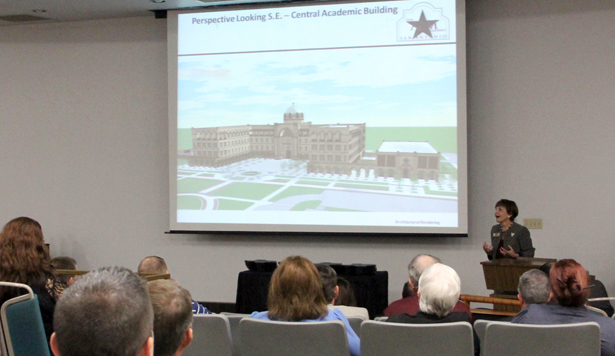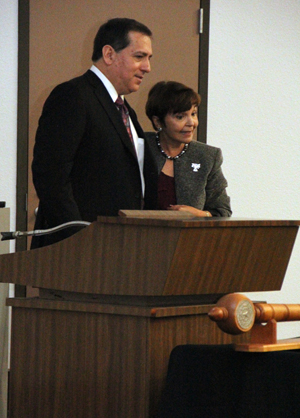
By Laura De Leon
President Maria Hernandez Ferrier said at convocation Aug. 27 that the University plans to have a shovel in the ground within the next month to begin building one of two new buildings. She said that the building will be the first thing you see when driving up University Way and will take 22 months to build.
“This will be an iconic building,” Ferrier said. She added that the Texas A&M Board of Regents and Chancellor John Sharp said, “Texas A&M University-San Antonio will be the most beautiful of the universities in the system.”
Monday’s faculty and staff convocation in the large auditorium of Brooks City-Base Campus kicked off a new academic year by presenting the University’s growth, facility expansion and service awards for employees who have been with the institution five and 10 years.
In a presentation titled “Texas A&M University-San Antonio, Changing the Landscape of San Antonio Forever,” Ferrier summarized the University’s trajectory for new and returning faculty and staff.
Describing campus growth, Ferrier said that the campus “ethnicity really mirrors the city of San Antonio.” Data provided by the University’s enrollment office showed that 63 percent of students enrolled in fall 2011 were Hispanic.
The University is reaching its enrollment benchmarks. The campus’ enrollment rate has risen 148 percent from fall 2008 to fall 2012. Total enrollment for fall 2011 was 3,554 with 79 percent coming from Bexar County. Ferrier said this is wonderful because the University reflects the city that it serves.
Seventy four percent of the student body is first in the family to attend college.
“That’s amazing,” Ferrier said. “Without great faculty and great staff that would have never happened.”
Responding to the University’s fast enrollment growth, administrators are planning to downward expand and begin accepting freshman and sophomores in 2014. Currently, 85.5 percent of students transfer from the Alamo Colleges.
While plans are already underway to transition to a four-year institution, Ferrier said that the University will continue to strive to maintain a seamless transition for the city’s community college students.
Campus develops as enrollment increases
Ferrier reviewed the campus development plan, which is outlined in six phases through 2025 at which point the student population is expected to reach 25,000. During phase I (2012), construction will begin on two new buildings; the Central Academic Building and the Patriots’ Casa were funded through a $75 million permanent university fund approved Feb. 9 by the Texas A&M System Board of Regents.
The 23,000-square-foot Patriots’ Casa is intended to offer veteran services and assistance as well as counseling and certificate programs. The building is designed to meet the needs of veterans, which make up 11 percent of the student body. Plans for the future include a master’s in counseling with an emphasis on military families.
At 186,000 square feet, the four-story Central Academic Building is significantly larger than Main Campus Building and will include an auditorium.
In addition, several high priority objectives have been placed on an exceptional item request and the University may ask the Legislature for funding. These requests include:
- Student Retention and Success Reintegration of Wounded Warriors and Veterans ($8 million);
- downward expansion ($11 million) and;
- partnership for advancement of first generation Hispanic students ($2 million).
The University may also request a tuition revenue bond to fund:
- a science and technology building ($70 million) and;
- infrastructure for campus development ($16.5 million).
“We didn’t just come up with this,” Ferrier said about the plans. “We really did a lot of research,” she added, mentioning that they looked at many different universities to fund growth and expansion.
Funding for programs, services and facilities are in anticipation of fulfilling the University’s campus development plan. At buildout, the final phase will have an expectant 25,000 enrollment and will include nine academic buildings, an athletic building, a library and campus housing.
Ferrier commended faculty and staff for reaching and outlining new departmental goals. The University’s three schools — School of Arts and Sciences, School of Business and School of Education and Kinesiology — have set priorities that are intended to ensure an education that will benefit students post graduation.
Ferrier noted the School of Education and Kinesiology’s teacher preparation programs, the School of Arts and Sciences’ water technology initiative and the School of Business’ center for cyber security and affordable degree program initiated by business Professor Carolyn Green.
Ferrier also noted the School of Business’ E-book program, launched in fall 2011 and funded by a Department of Education grant facilitated by School Head Tracy Hurley.
Convocation keynote speaker

Dr. Roger Campos, member of the Texas A&M San Antonio Foundation Board, delivered the keynote address. Campos reminded faculty that they are a major influence in students’ lives.He said that you never know what kind of influence you can be toward a person.
“We all can impact lives and often unexpectedly play important roles that change a person’s future dramatically,” he said.
Campos said he has witnessed inspiring traits on the A&M-San Antonio campus and said that teachers and staff are proud and beneficial to its students.
“Our community, our citizens and most of all our students get to come, deserve this campus and all the opportunity it holds for them,” he said quoting Senator Frank Madla, who authored SB 800 to create A&M-San Antonio.
Jillian Reddish, communications specialist and Staff Council president, presented the first round of service awards for employees who have been with the University five and 10 years. Recipients were recognized and given a Texas shaped plaque engraved with their name, years worked and a specialized A&M-San Antonio design.
“This is the first time that we’ve done this and I hope this is the beginning of a long tradition for us all,” Reddish said.
Five year recipients: Remigio L. Garcia, Vivien L. Geneser, Joann P. Gonzalez, Barbara A. Hewitt, Robin D. Kapavik, Cynthia M. Lee, Jingquan Li, Margarita Vasquez and Robert F. Vasquez. Joel S. De La Rosa and Joni L. Foster were presented but not present.
Ten year recipients: Kimberly S. Barker, Gary F. Coulton, Josephine S. Fey, Carolyn W. Green, Sonya R. Guerra, Patricia A. Holmes, Tracy A. Hurley, James Jurica, Rosario Torres-Raines, Samuel K. Rock and Francisco Sanchez (not present).
“We are all about building these traditions,” Ferrier said, “so this is certainly a wonderful one.”






